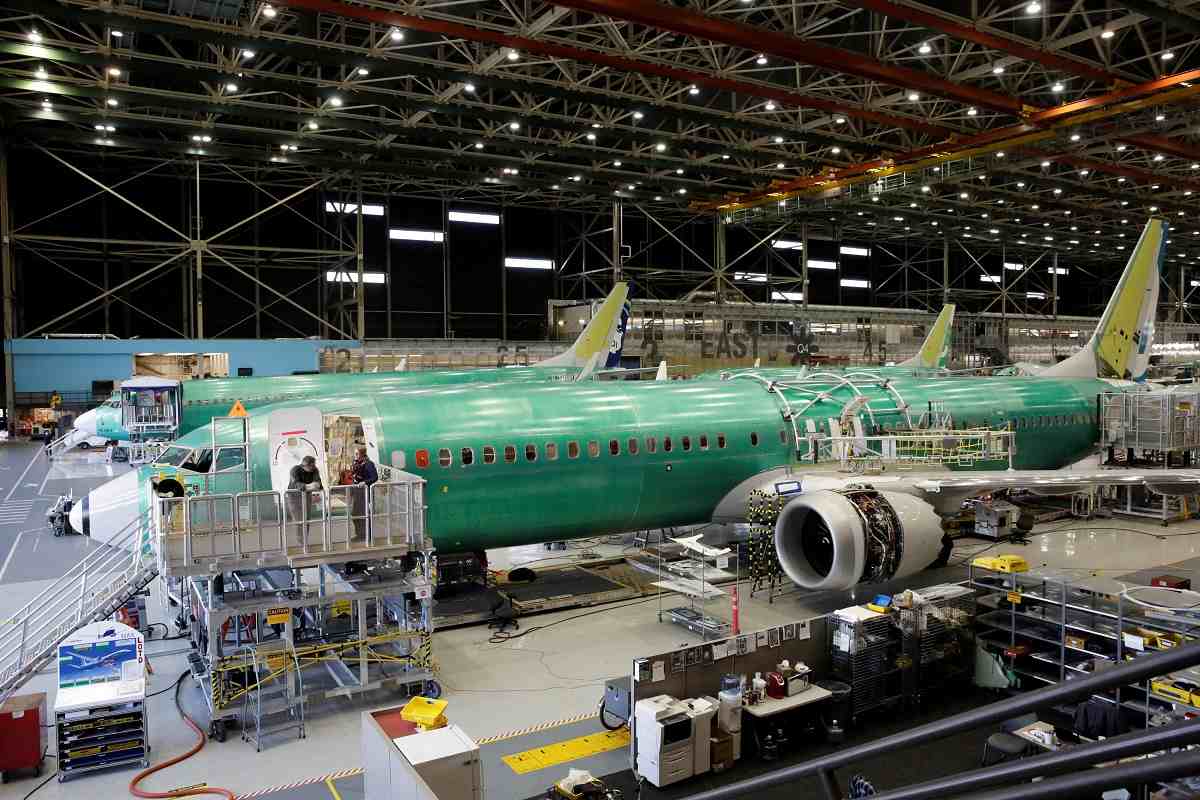
Boeing’s new 737 MAX-9 is pictured under construction at their production facility in Renton, Washington, U.S., February 13, 2017. Picture taken February 13, 2017.
16:21 JST, January 25, 2024
WASHINGTON (Reuters) – The U.S. Federal Aviation Administration late on Wednesday tightened pressure on Boeing BA.N by barring the troubled planemaker from expanding production of its best-selling 737 MAX narrowbody planes, following “unacceptable” quality issues.
The unprecedented decision looked set to deepen turmoil at Boeing even as the FAA also agreed to allow the 737 MAX 9, which was grounded after a mid-air blowout on an Alaska Airlines jet on Jan. 5, to resume flying once inspections were completed.
The ability to resume flying was a relief to U.S. operators Alaska Airlines and United Airlines, which had been forced to cancel thousands of flights and aim to begin returning the planes to service on Friday and Sunday, respectively.
But the FAA decision to keep Boeing from expanding production will have wide-ranging effects across the industry.
Boeing is seeking to increase production of its single-aisle 737 MAX family to keep pace with demand and close a gap in the jet market with European planemaker Airbus.
Analysts have expressed concerns that extra scrutiny of Boeing factories following the MAX 9 door plug blowout would temper production increases for the smaller and more widely sold MAX 8, a key source of cash for Boeing and many suppliers.
“We will not agree to any request from Boeing for an expansion in production or approve additional production lines for the 737 MAX until we are satisfied that the quality control issues uncovered during this process are resolved,” FAA Administrator Mike Whitaker said.
“The quality assurance issues we have seen are unacceptable.”
Clarifying the order, the FAA subsequently told Reuters: “That means Boeing can continue producing at the current monthly rate, but they cannot increase that rate.”
Boeing said it would continue to cooperate “fully and transparently” with the FAA and follow the agency’s direction as it took action to strengthen safety and quality.
The FAA offered no estimate of how long the limitation would last and did not specify the number of planes Boeing can produce each month.
In October, Boeing CEO Dave Calhoun said it planned to reach production of 38 MAX planes per month by the end of 2023.
Boeing’s latest 737 master schedule, which sets the production pace for suppliers, calls for production to rise to 42 jets per month in February, 47.2 in August, 52.5 by February 2025 and 57.7 in October 2025, Reuters reported in December.
However, Boeing’s own production pace can lag the supplier master schedule.
The FAA’s decision could impact plans to stand up a new 737 MAX line in Everett, Washington, by mid-year 2024, following the end of production of Boeing’s iconic 747 in the massive plant.
The line, set to be the fourth 737 line overall and the first outside Renton, is needed to meet strong demand.
Boeing declined to comment on any potential impact on the Everett line.
Once accused of being too soft on Boeing, the FAA has toughened oversight since earlier MAX crashes led to a worldwide grounding, but Wednesday’s intervention opens new territory, experts said.
Jefferies analysts said the FAA halt to expansion seemed “restrictive” and lacked a definitive timeline.
“These actions (are) likely put pressure on any near-term production ramp, but appear to be more timing related,” they added.
Some airlines could be “significantly” impacted by any freeze on higher production, a senior industry source said, though many in the industry have already factored in some delays as aerospace firms continue to recover from the pandemic.
United, for example, has 100 MAX deliveries scheduled for this year, according to a regulatory filing in October.
Boeing shares fell 2% in after-hours trading on Wednesday.
CHINA MAX DELIVERIES RESUME
The FAA announcement came hours after Boeing delivered its first 737 MAX to a Chinese airline since March 2019, ending an almost five-year freeze and granting a respite for strained trade relations between the world’s two largest economies.
Boeing CEO Dave Calhoun faced questions from senators on the Alaska Airlines incident in a series of meetings on Wednesday on Capitol Hill. Senate Commerce Committee chair Maria Cantwell said she would hold hearings to investigate the root cause of Boeing’s safety lapses.
“The American flying public and Boeing line workers deserve a culture of leadership at Boeing that puts safety ahead of profits,” Cantwell said.
Calhoun said Boeing would restore public confidence in its airplanes.
“We don’t put planes in the air that we don’t have 100% confidence in,” Calhoun told reporters.
The China delivery is a boost during a difficult period for Boeing following the mid-air cabin blowout during a nearly full flight. No one was killed in the incident, but regulators and industry insiders are applying new scrutiny to the planemaker’s manufacturing and quality control processes as a result.
China is one of the fastest-growing aerospace markets, which the company projects will account for 20% of the world’s aircraft demand through 2042.
It was China that first grounded MAX jets after a pair of crashes in 2018 and 2019 that killed nearly 350 people.
While safety bans have been lifted with existing MAX jets flying inside China, new deliveries had remained on hold.
A 737 MAX 8 registered to China Southern Airlines 600029.SS left Seattle Boeing field in Washington state at 11:55 a.m. Pacific Time (1955 GMT) on Wednesday and landed in Honolulu almost seven hours later, flight data from FlightRadar24 shows, before its final destination in China.
Boeing declined to comment. China Southern and China’s aviation regulator did not immediately respond to requests to comment.
"News Services" POPULAR ARTICLE
-

American Playwright Jeremy O. Harris Arrested in Japan on Alleged Drug Smuggling
-

Japan’s Nikkei Stock Average as JGB Yields, Yen Rise on Rate-Hike Bets
-

Japan’s Nikkei Stock Average Licks Wounds after Selloff Sparked by BOJ Hike Bets (UPDATE 1)
-

Japan’s Nikkei Stock Average Buoyed by Stable Yen; SoftBank’s Slide Caps Gains (UPDATE 1)
-

Japanese Bond Yields Zoom, Stocks Slide as Rate Hike Looms
JN ACCESS RANKING
-

Keidanren Chairman Yoshinobu Tsutsui Visits Kashiwazaki-Kariwa Nuclear Power Plant; Inspects New Emergency Safety System
-

Imports of Rare Earths from China Facing Delays, May Be Caused by Deterioration of Japan-China Relations
-

University of Tokyo Professor Discusses Japanese Economic Security in Interview Ahead of Forum
-

Japan Pulls out of Vietnam Nuclear Project, Complicating Hanoi’s Power Plans
-

Govt Aims to Expand NISA Program Lineup, Abolish Age Restriction























